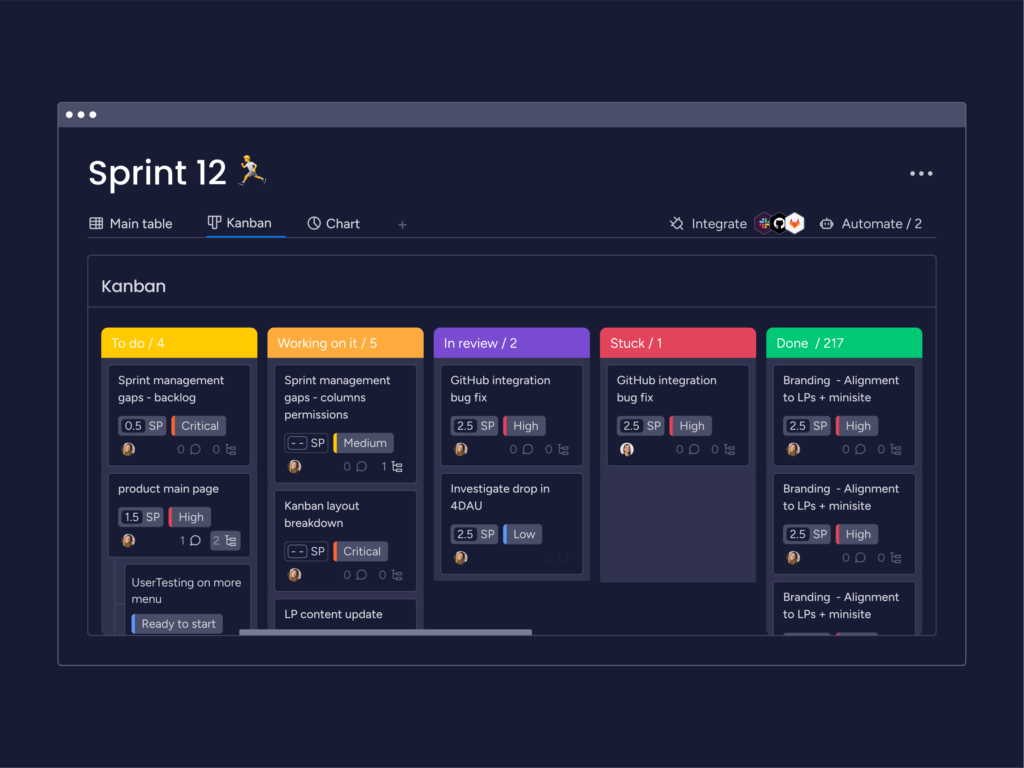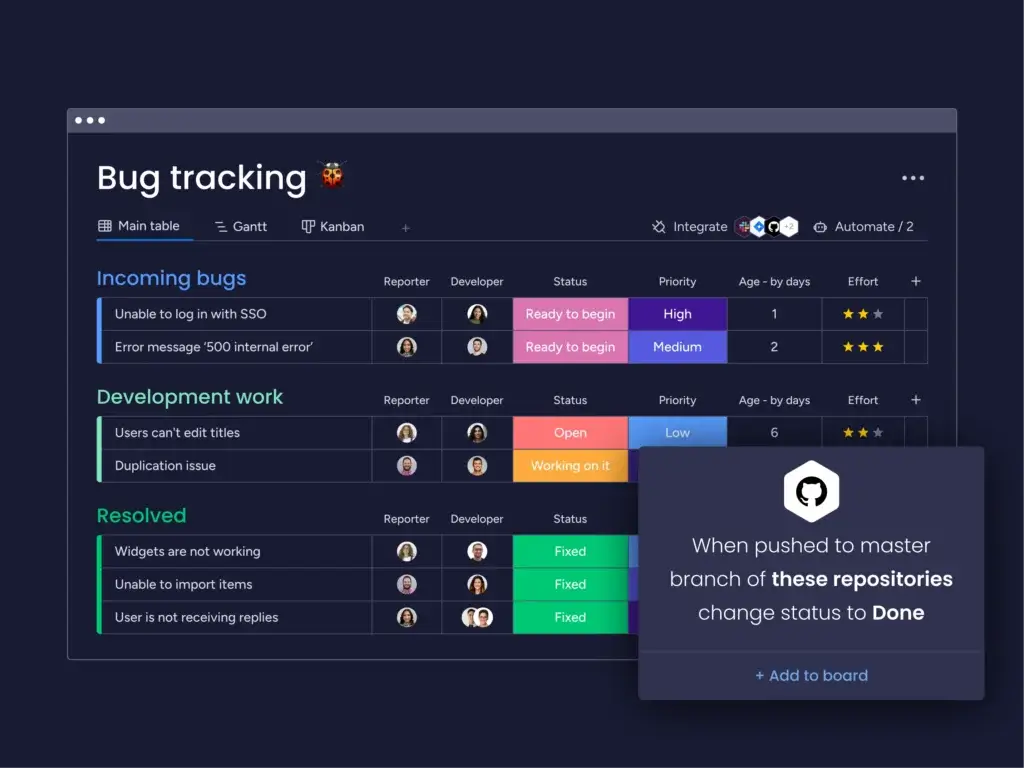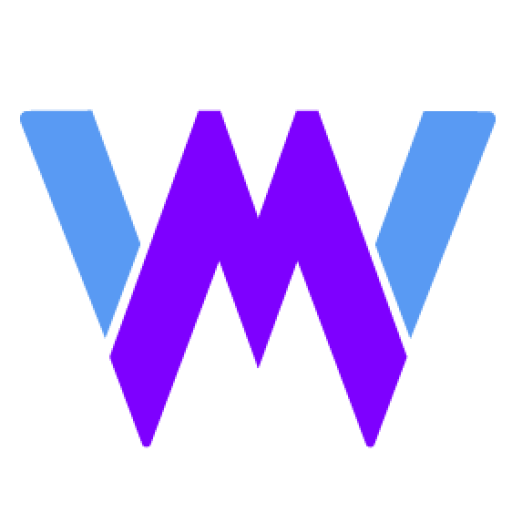Introduction
Choosing the right work management platform can make or break a product release. You need a solution that helps you plan, track, and ship software quickly without drowning in administrative overhead. monday Dev aims to deliver this by extending monday.com’s Work OS into a full‑fledged agile development hub. In this monday Dev review, you’ll learn how the platform works, its key features, pricing, advantages, and drawbacks. The goal is to help you decide whether monday Dev is the right fit for your development team or if an alternative might suit you better.
What is monday Dev?
monday Dev is an agile product lifecycle management platform built on the same foundation as monday.com’s Work OS. It’s designed specifically for product and engineering teams who need to plan roadmaps, manage sprints, track bugs, and coordinate releases in a single workspace. Unlike general project management tools that require extensive configuration or separate add‑ons for development, monday Dev bundles essential features for each stage of the product lifecycle: planning, executing, releasing, monitoring, and managing.
The tool aims to bridge the gap between technical teams and the rest of the organization. Sales, marketing, and customer success teams can follow development progress without learning a complex system. monday Dev integrates with developer tools like GitHub and GitLab, provides AI‑assisted standups and retrospectives, and offers real‑time dashboards so leaders can make data‑driven decisions.
Software Specification
monday Dev’s Core Features
monday Dev packages its capabilities into five phases—Plan, Execute, Release, Monitor, and Manage—so your team can move quickly from idea to deployment.
Plan: Prioritize customer‑centric roadmaps
- Feature prioritization and roadmap visualization: Capture customer feedback and feature requests in a centralized backlog. Use prioritization frameworks and customizable fields to rank ideas and visualize their place on the roadmap.
- Hierarchies: Link strategic initiatives to epics, user stories, sprints, and individual tasks. Hierarchy views help you understand how day‑to‑day tasks roll up to company objectives.
- Capacity planning: Plan your sprints based on team availability and past velocity. Capacity planning helps you avoid overcommitment and ensures workloads are realistic.
- Customer feedback management: Gather customer requests directly in monday Dev and connect them to backlog items. This alignment helps prioritize features that have the biggest impact.
Execute: Run efficient sprints
- Scrum and Kanban boards: Visualize tasks in the workflow that suits your team. Scrum boards let you plan sprints and track burndown charts, while Kanban boards support continuous flow.
- Sprint management: Plan sprints, set sprint goals, assign tasks, and track progress in one view. The AI Sprint Summary tool provides retrospective insights after each sprint, highlighting velocity, unplanned work, and improvement recommendations.
- AI Daily Standup: Automate daily standups with AI‑generated task summaries and suggested next steps. A built‑in timer keeps meetings concise, and “shuffle” mode changes the speaking order to keep participants engaged.
- Sprint automations: Reduce manual work with triggers for status changes, due‑date reminders, and integration events. Automations free engineers from administrative tasks so they can focus on shipping software.
Release: Coordinate launches across teams
- Shareable release plan and roadmap tracker: Create release plans that other departments can access. A shared roadmap aligns engineering, product, marketing, and customer teams around launch milestones.
- Product documentation: Collaborate on product requirement documents (PRDs), specifications, and wikis using built‑in collaborative documents.
- Release management dashboards: Visualize progress toward release goals, track dependencies, and identify blockers. Real‑time dashboards provide cross‑team visibility.
Monitor: Track bugs and incidents
- Bug reporting flow: Capture bug reports from users or internal testers and triage them automatically. Customizable forms can categorize bugs by severity, feature area, or reproduction steps.
- Incident monitoring and real‑time alerts: Monitor incidents and service disruptions. monday Dev integrates with incident management tools to streamline responses.
- AI‑assisted bug triage: An AI copilot can categorize bugs automatically, summarize issue details, and assign tasks to the right engineer, ensuring nothing slips through the cracks.
Manage: Analyze performance and scale processes
- Real‑time analytics: Dashboards show key metrics like sprint velocity, cycle times, and issue resolution rates. Visual widgets help identify bottlenecks and measure team performance.
- Burndown and velocity charts: Track how many story points remain in a sprint and compare planned versus actual velocity across sprints. These charts help adjust commitments for future iterations.
- Cross‑team collaboration: Use shareable roadmaps and dashboards to align engineering with product, design, support, and executive teams. Collaborative documents serve as the single source of truth for requirements and retrospectives.
- Automation of repetitive tasks: Automate engineering workflows such as assigning issues based on labels, updating statuses after code merges, or syncing information with GitHub and GitLab.
Integrations and AI Features
monday Dev integrates with developer tools to streamline your workflow. GitHub, GitLab, and CircleCI integrations allow code commits, pull requests, and pipeline statuses to appear directly in monday Dev boards. Slack, Teams, and other communication apps ensure notifications reach the right people. The AI functionality doesn’t stop at standups; the platform can summarize product documentation, categorize requests, and suggest optimal workloads based on historical data.
For example, the Performance Tab gives you real‑time insight into code review bottlenecks by pulling data from GitHub. The AI engine analyzes your team’s historical performance and capacity to recommend sprint scopes. These predictive insights help you plan realistically and avoid mid‑sprint surprises. monday Dev’s AI features aim to reduce administrative overhead while providing meaningful recommendations.

Pros and Cons
Advantages and Disadvantages
Positive
✅ High level of customization
✅ Integrated developer tooling
✅ AI‑powered efficiency
✅ Real‑time reporting and dashboards
Negative
❌ Learning curve
❌ Requires some technical knowledge
❌ Limited offline capabilities
❌ Performance with large datasets
Every tool has strengths and weaknesses. Evaluating both sides helps you understand where monday Dev shines and where it might fall short.
✅ Pros
- High level of customization
You can tailor boards, item types, statuses, and automation rules without writing code. Drag‑and‑drop views make it easy to build sprints, backlogs, or portfolio dashboards that reflect your team’s workflow. Hierarchies keep your epics and tasks aligned, and custom fields let you track KPIs unique to your product. - Integrated developer tooling
Native integrations with GitHub, GitLab, and CI/CD pipelines let you connect code repositories directly to tasks. Pull requests appear on task cards, and you can trigger automations when code is merged or builds fail. This integration reduces context switching between tools and centralizes information about code changes, builds, and release status. - AI‑powered efficiency
Automated standups and retrospectives save hours every week. The AI analyses historical performance data to recommend sprint scope, identify risk, and suggest next steps. By summarizing documentation and categorizing bug reports, the AI reduces manual administrative work so your team can focus on coding and delivering value. - Real‑time reporting and dashboards
monday Dev’s dashboards provide immediate insight into project health. Velocity charts, cumulative flow diagrams, and release readiness indicators are available out of the box. Customizable widgets help stakeholders track what matters most to them, whether it’s bug resolution times, sprint progress, or customer feedback trends. - Collaboration across the organization
Because monday Dev is built on the same platform as monday.com’s other products, non‑technical departments can join the conversation without extra licensing complexity. Sales teams can log feature requests, customer support can report bugs, and marketing can plan launch activities within the same workspace. This reduces miscommunication and fosters alignment. - Scalability for growing teams
monday Dev supports small startups through to enterprise‑level organizations. Unlimited viewer seats allow executives or stakeholders to monitor progress without being billed as full users. With Enterprise tier features like role‑based permissions, advanced security, and custom onboarding, the platform scales as your team and regulatory requirements grow.
❌ Cons
- Higher cost compared to some competitors
The per‑seat pricing can be more expensive than tools such as Jira, ClickUp, or Zoho Sprints, especially when you cross seat bundles. The lack of a permanently free plan makes monday Dev less appealing for very small teams or hobby projects. - Steeper learning curve for newcomers
Although the interface is visually appealing, the sheer number of features and customization options can overwhelm new users. Teams transitioning from simpler tools may need onboarding time to grasp hierarchies, automations, and advanced reporting. - Limited mobile functionality
The mobile app, while useful for viewing tasks and communication, lacks some advanced functionality available in the desktop version. Creating complex automations or editing dashboards can be cumbersome on a smartphone. For teams that need full mobile access, this may be a drawback. - Dependence on internet connectivity
monday Dev is cloud‑based and requires a stable internet connection. While offline editing in docs is possible, most functionality requires live data synchronization. Teams in regions with unreliable connectivity should consider this when evaluating the platform. - Bundled seat pricing
monday Dev’s seat bundles mean you pay for predefined blocks of users (5, 10, 15, etc.). If your team grows beyond a block, costs can jump even if you only need one extra seat. This pricing model can be less flexible than per‑user billing.

User Experience
How It Feels Like For The User
When you start using monday Dev, you’ll notice how intuitive it feels despite its developer-oriented depth. The interface builds on the familiar monday.com workspace, so if you’ve used monday Work Management before, you’ll feel right at home.
Streamlined Navigation
You can easily switch between backlogs, sprints, and roadmaps using color-coded boards and custom views. The sidebar layout makes it simple to move from a bug-tracking board to a sprint report without losing context.
✅ Tip: Use the split view to track both issues and progress metrics side by side – perfect for sprint retrospectives.
Customizable Workflows
Every element, from columns to automation rules, can be customized. You can create fields for “Story Points,” “Sprint Status,” or “Pull Request Links,” helping your team visualize development cycles without jumping between tools.
🔧 monday Dev also supports drag-and-drop task prioritization, allowing you to adjust sprint focus quickly.
Collaboration Made Easy
Real-time updates keep everyone on the same page. You’ll get automatic notifications for code changes, task dependencies, and release notes. The platform’s comment threads and mention system let developers, QA testers, and product managers collaborate directly under each task.
💬 Example: When a developer marks an issue as “Ready for QA,” monday Dev automatically alerts the QA lead, who can view details, assign a tester, and link results back to GitHub, all without leaving the board.
Visual Clarity and Speed
The UI is lightweight and responsive, even with large boards or complex automations. Dark mode, quick filters, and AI-powered summaries (like daily standups) make it efficient for remote and hybrid teams.
📊 Built-in dashboards provide visual insights, sprint burndown charts, release progress bars, and workload heatmaps, giving you a clear overview of performance at a glance.

Pricing
How Much Does monday Dev Cost?
monday Dev offers four main plans: Basic, Standard, Pro, and Enterprise. Pricing is charged per user seat on a group basis; you pay for a fixed bundle of seats rather than individual seats, which can make costs jump if you cross a seat threshold. All paid plans include a free trial.
| Plan Type | monday Dev | Key features |
| Basic | Starts around $9 per user/month | Unlimited viewers and items, dedicated development templates, wiki & docs, and dashboards on a single board. Suitable for small teams experimenting with agile processes. |
| Standard | Starts around $14 per user/month | Includes timeline and Gantt views, guest access, sprint management, a single product roadmap, GitHub integration, and up to 250 monthly automations. Good for teams that need classic agile boards and code repository integration. |
| Pro | Starts around $23 per user/month | Adds private boards, time tracking, advanced agile reporting, cross‑team roadmaps, customer feedback management, and up to 25 000 monthly automations. This tier is popular among growing development organizations that need deeper analytics and automation. |
| Enterprise | Custom pricing with advanced security & AI features | Offers enterprise‑scale automations and integrations, advanced security, multi‑level permissions, extensive reporting, and tailored onboarding. Best for large organizations with strict compliance requirements and complex workflows. |
Note that monday Dev does not offer a permanently free plan, only a trial. Pricing is generally higher than competitors like Jira or Trello, but the plans bundle features such as AI automation and integrated dashboards that would require paid add‑ons elsewhere. Paying annually can save approximately 18%, and early adopters may have legacy pricing until their contract renews.
Compare with Others
Alternatives to monday Dev
To determine whether monday Dev is the right choice, it’s helpful to compare it with both its sibling product monday Work Management and leading alternatives such as Jira. The table below highlights key differences.
| Feature Type | monday Dev | Jira |
| Purpose | End‑to‑end product lifecycle management for software teams | Issue tracking and agile project management for development teams |
| Pricing Model | Per‑seat bundles with no permanent free tier | Per‑user pricing with free plan for up to ten users |
| Hierarchy & Roadmaps | Built‑in hierarchies connecting initiatives to epics, stories, and tasks | Requires configuration or add‑ons for hierarchical views |
| AI Capabilities | AI daily standups, sprint summaries, capacity suggestions | Limited native AI features; relies on third‑party plugins |
| Developer Integrations | Native GitHub/GitLab/CI integrations; performance tab | Strong Atlassian ecosystem integrations; Bitbucket integration |
| Reporting & Dashboards | Real‑time dashboards included; customizable widgets | Robust reporting with advanced filters; some features require paid add‑ons |
| Ease of Use | User‑friendly interface with drag‑and‑drop boards | Complex for new users; configuration often requires admin expertise |
| Customer Support | 24/7 support on all paid plans; extensive help center | Standard support with upgrade options for priority tiers |
While Jira is a mature, widely adopted agile platform, monday Dev aims to simplify the user experience and broaden cross‑team collaboration. If your organization values AI‑assisted standups, intuitive roadmaps, and out‑of‑the‑box dashboards, monday Dev may offer more value despite a higher cost. Conversely, Jira might be more suitable for teams that need advanced permission schemes, rely heavily on the Atlassian ecosystem, or prefer a free starter tier.
Use Cases and Best Practices
How to get the most out of monday Dev
When monday Dev makes sense
- Agile software development teams: If your team follows Scrum or Kanban and requires integrated sprint planning, backlog management, and developer tool integration, monday Dev provides an all‑in‑one environment.
- Cross‑functional product teams: monday Dev shines when product management, design, engineering, and business teams need a shared platform to discuss features, prioritize roadmaps, and plan releases.
- Companies switching from rigid tools: Teams frustrated with the complexity of traditional tools like Jira may appreciate monday Dev’s intuitive interface and no‑code customization.
- Growing organizations seeking scalability: monday Dev scales from a small team up to enterprise‑level operations, making it a good choice for startups planning to grow.
Tips for success
- Onboard gradually: Start with one or two boards—such as backlog management and sprint tracking—before rolling out advanced features. This helps your team get comfortable without overwhelming them.
- Leverage templates: monday Dev provides templates for product roadmaps, sprint boards, bug queues, and release plans. Customize these rather than building from scratch.
- Automate repetitive tasks: Identify manual steps that occur every sprint—like assigning tasks or sending status updates—and use built‑in automations to streamline them.
- Align with stakeholders: Share dashboards and roadmaps with non‑technical stakeholders early. Encourage feedback to ensure everyone is aligned on priorities and progress.
- Monitor metrics: Use velocity charts and capacity planning tools to evaluate team performance. Adjust sprint scope based on historical data rather than gut feeling.

Security and Compliance
What about security?
Customer Support and Onboarding
How is monday Dev support
You’re never left on your own when using monday Dev. The platform combines guided onboarding with responsive support and a wealth of self-serve learning resources.
24/7 Global Assistance
All paid plans include 24/7 email and chat support. Enterprise customers gain access to dedicated success managers, priority response SLAs, and personalized onboarding sessions for large development teams. Support agents are available across multiple time zones to assist with everything from workflow automation to GitHub integration troubleshooting.
Extensive Knowledge Base
The monday Help Center offers hundreds of tutorials, best-practice templates, and community discussions. You’ll find step-by-step guides for setting up agile sprints, automation recipes, and integrating tools like Jira or GitLab.
💡 Example: Search “automate sprint closure” in the Help Center to find workflows that automatically move all completed items to your next iteration board.
Developer-Friendly Resources
monday Dev’s developer documentation is another plus. You can use the monday GraphQL API or SDKs to build custom integrations, trigger automations, or extend features like time tracking or QA reporting. The community Slack channels and webinars also help product managers and developers share agile best practices.
Conclusion
Final Thoughts
monday Dev brings agile development workflows, product roadmaps, bug tracking, and release management together into one flexible platform. Its AI‑assisted features, daily standups, sprint summaries, capacity planning, and bug triage, save time and help you make data‑driven decisions. Real‑time dashboards and hierarchical roadmaps keep stakeholders aligned, and native integrations reduce context switching.
The platform isn’t perfect: it’s pricier than some competitors, has a learning curve, and its mobile capabilities lag behind the desktop experience. Yet for growing teams seeking a comprehensive, intuitive solution that connects developers with the rest of the business, monday Dev is a strong contender. If you’re tired of juggling multiple tools or managing complex configurations, monday Dev could streamline your workflow and accelerate product delivery.
Have more questions?
Frequently Asked Questions
-
Is monday Dev free?
monday Dev offers a 14‑day free trial but does not have a permanently free plan. Paid plans start around $9 per user per month. -
What’s the difference between monday Dev and monday Work Management?
monday Dev focuses on software development workflows with sprint management, Git integrations, and AI standups. monday Work Management is a general project and task management platform suited for a wide range of departments. Many organizations use both: Work Management for traditional projects and Dev for agile product development. -
Does monday Dev replace Jira?
For many teams, yes. monday Dev can serve as a full Jira alternative by offering sprint boards, backlog management, and issue tracking. However, some organizations may still prefer Jira’s deep customization and robust plugin ecosystem. -
How does monday Dev handle GitHub and GitLab integrations?
You can connect repositories to tasks, view pull requests and commits on boards, and trigger automations when code is merged. The Performance Tab provides visibility into code review bottlenecks. -
Can non‑technical stakeholders use monday Dev?
Absolutely. monday Dev’s user‑friendly interface and unlimited viewer seats make it easy for sales, marketing, and leadership teams to monitor progress, request features, and collaborate with developers. -
Is there a mobile app for monday Dev?
Yes, monday.com provides mobile apps for iOS and Android. The apps let you view boards, update statuses, and communicate, but complex automations and advanced reporting are best managed via the desktop interface. -
How secure is monday Dev?
The platform uses encryption, secure AWS hosting, and complies with standards such as SOC 2 Type II. Enterprise plans include advanced security features like single‑sign‑on, audit logs, and permission controls. -
Does monday Dev offer AI features?
Yes, the platform includes AI‑powered daily standups, sprint summaries, capacity recommendations, bug triage, and document summarization. These features aim to reduce administrative work and provide actionable insights. -
How is pricing structured?
Pricing is based on seat bundles rather than individual users. You pay for a minimum seat package (e.g., 5, 10, 15 seats). Annual billing typically yields an 18% discount compared to monthly plans. -
What kind of support does monday Dev provide?
All paid plans receive 24/7 support via chat and email, access to webinars and tutorials, and a comprehensive knowledge base. Enterprise customers get tailored onboarding and dedicated account managers.








